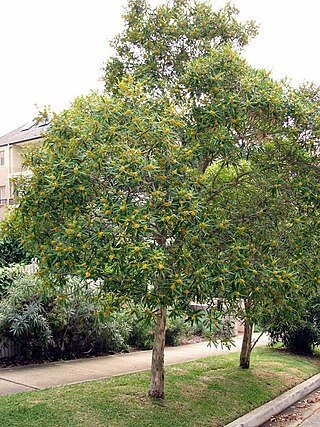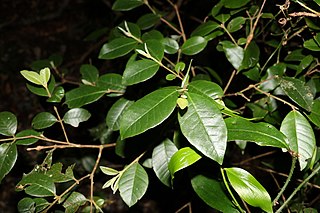
Myrtaceae, the myrtle family, is a family of dicotyledonous plants placed within the order Myrtales. Myrtle, pōhutukawa, bay rum tree, clove, guava, acca (feijoa), allspice, and eucalyptus are some notable members of this group. All species are woody, contain essential oils, and have flower parts in multiples of four or five. The leaves are evergreen, alternate to mostly opposite, simple, and usually entire. The flowers have a base number of five petals, though in several genera, the petals are minute or absent. The stamens are usually very conspicuous, brightly coloured, and numerous.

Syzygium is a genus of flowering plants that belongs to the myrtle family, Myrtaceae. The genus comprises about 1200 species, and has a native range that extends from Africa and Madagascar through southern Asia east through the Pacific. Its highest levels of diversity occur from Malaysia to northeastern Australia, where many species are very poorly known and many more have not been described taxonomically. One indication of this diversity is in leaf size, ranging from as little as a half inch to as great as 4 ft 11 inches by sixteen inches in Syzygium acre of New Caledonia.

Tristaniopsis is a genus of shrubs and trees in the myrtle family Myrtaceae described as a genus in 1863. They have a wide distribution in Southeast Asia, New Guinea, New Caledonia and Australia.

Asteromyrtus is a genus of flowering plants in the Myrtaceae family. It is closely related to Callistemon and Melaleuca.

Lenwebbia is a genus of shrubs or small trees in the myrtle family Myrtaceae. The type species is Lenwebbia lasioclada.

Blepharocalyx is a genus of plant in family Myrtaceae first described as a genus in 1854. It is native to South America and the West Indies.
- Blepharocalyx cruckshanksii(Hook. & Arn.) Nied. - Chile
- Blepharocalyx eggersii(Kiaerskou) L.R.Landrum - Lesser Antilles, Venezuela, Guyana, Peru, Brazil
- Blepharocalyx myriophyllus Mattos - Minas Gerais
- Blepharocalyx salicifolius(Kunth.) O.Berg - Brazil, Bolivia, Peru, Ecuador, Paraguay, Uruguay, N Argentina
Thaleropia is a genus of flowering plants in the family Myrtaceae first described as a genus in 1993. It is native to Queensland and Papuasia.
Myrteola is a plant genus in the Myrtaceae described as a genus in 1856. It is native to South America and the Falkland Islands.
Ristantia is a group of plants in the family Myrtaceae described as a genus in 1982. The entire genus is endemic to the State of Queensland in Australia.
- Ristantia gouldiiPeter G. Wilson & B. Hyland - a tree species listed as vulnerable
- Ristantia pachysperma(F.Muell. & F.M.Bailey) Peter G.Wilson & J.T.Waterh.
- Ristantia waterhouseiPeter G.Wilson & B.Hyland

Homalocalyx is a genus of shrubs in the family Myrtaceae described as a genus in 1857. The entire genus is endemic to Australia.
Kjellbergiodendron is a genus of the botanical family Myrtaceae, first described as a genus in 1936. It contains only one known species, Kjellbergiodendron celebicum, endemic to the Island of Sulawesi in Indonesia.
Mitrantia is a genus of plant in family Myrtaceae described as a genus in 1988. It contains only one known species, Mitrantia bilocularis, endemic to the State of Queensland in northeastern Australia.
Myrtastrum is a genus of plants in the Myrtaceae first described as a genus in 1941. It contains only one known species, Myrtastrum rufopunctatum, endemic to New Caledonia. It is a phylogenetically isolated genus within the tribe Myrteae.

Neomyrtus is a genus of plants in the family Myrtaceae described in 1941. It contains only one known species, Neomyrtus pedunculata, endemic to New Zealand. It is found there on both the North Island and the South Island.

Pleurocalyptus is a group of shrubs and small trees in the family Myrtaceae, first described as a genus in 1868. The entire genus is endemic to New Caledonia. It is closely related to Xanthostemon.
Purpureostemon is a genus of plant in the myrtle family Myrtaceae described as a genus in 1939. There is only one known species, Purpureostemon ciliatus, endemic to New Caledonia. Purpureostemon is related to Xanthostemon.
Sphaerantia is a group of flowering plants in the family Myrtaceae, described as a genus in 1988. The entire genus is endemic to the northern part of the State of Queensland in Australia.
Whiteodendron is a genus of plant in family Myrtaceae described as a genus in 1952. It contains only one known species, Whiteodendron moultonianum, endemic to Borneo.

Syzygium forte, commonly known as flaky-barked satinash, white apple or brown satinash, is a tree in the family Myrtaceae native to New Guinea and northern Australia.
Syzygium apodophyllum is a tree in the Myrtaceae family endemic to north Queensland. The fruit is edible. It is a host for the exotic plant-pathogen fungus Austropuccinia psidii, which is causing a lot of damage to vegetation communities and economic plants.









